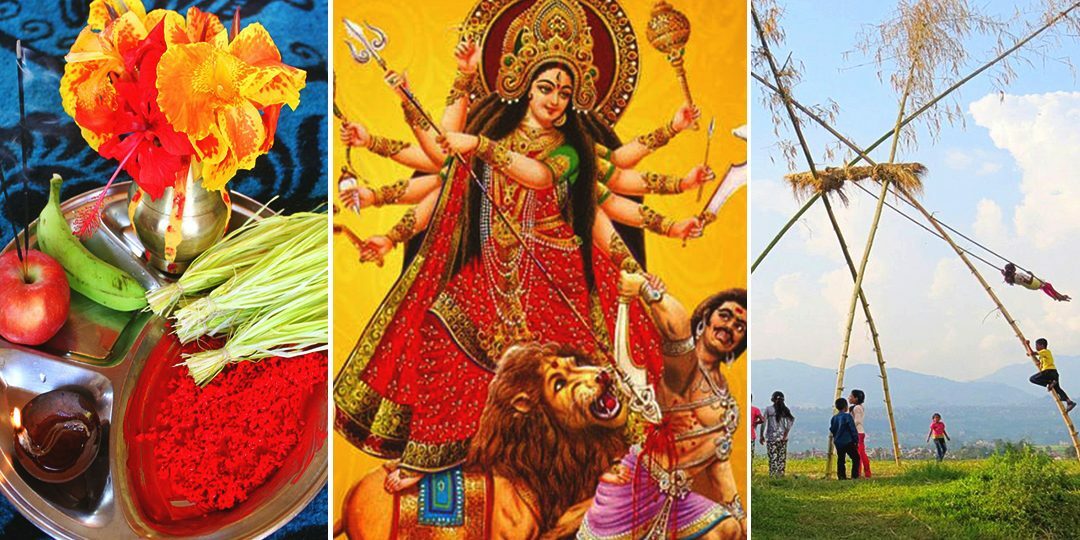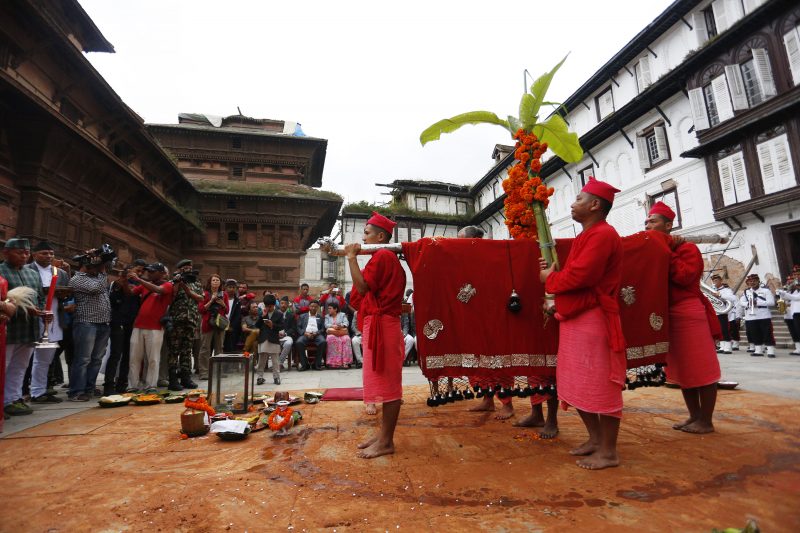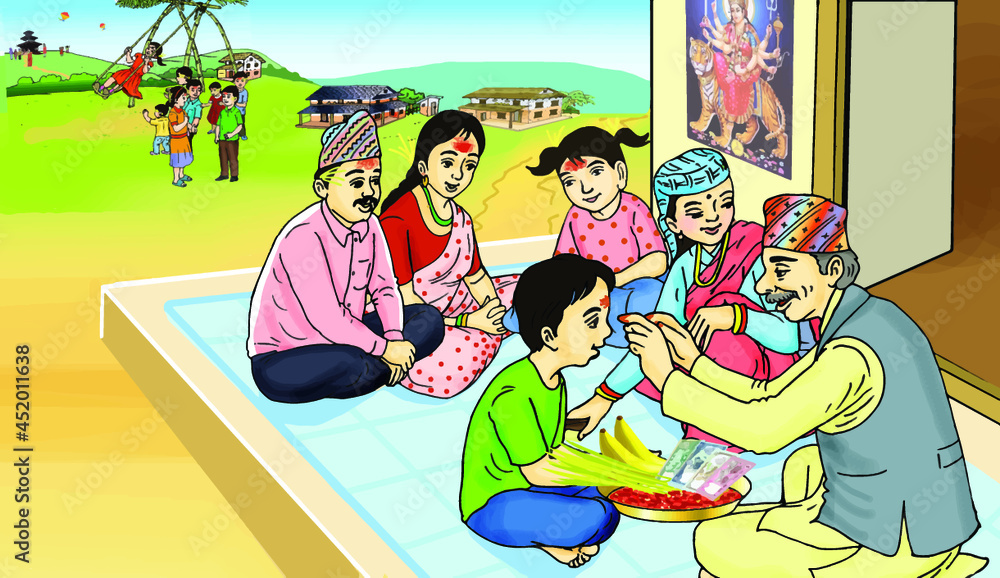
Festivals are the best way to catch up with family and rooted cultures. Dashain; a celebration of good over evil, is the Nepali version of the famous Dashera festival. It is an annual Nepali festival where families gather to indulge in twelve days of joy, goodness, traditional delicacies and bonding with the elderly.
The festivities of Dashain in Nepal begin with Shukla Paksh (bright lunar fortnight) and ends with the full moon day between months September or October. During this time, devotees cleanse their homes and decorate them vibrantly. The popular belief behind this practice is that the Goddess would visit and bless their homes. Families unite, markets fill with shoppers purchasing gifts, clothes to celebrate the Dashain Festival.
Animals such as goats, sheep, buffalos, chicken, ducks are prepared for slaughter as an offering to the deity. Most business organisations and firms remain shut for the duration of the festival. The entire country gathers to celebrate with their family and friends the festival of Dashain in Nepal.

How is Dashain Celebrated?
Kite flying is the most popular sport in every household during the Dashain Festival. The belief behind this practice is that kite flying would remind God to send more rain. The older family members indulge in playing cards and gambling. Buying and wearing all new clothes is an essential part of Dashain. Unique bamboo swings manufactured in the traditional manner using bamboo sticks, wood and ropes are set up during this time. These handicrafts; some of which are as tall as twenty feet are prepared a week before Ghatasthapana (translated to “establishing pots or vessels)
According to Hindu mythology, Mahishasura, the demon, was creating a ruckus and causing terror in the land of the Gods (Devaloke). It was then that Maa Durga killed him and saved the world from him. The first nine days of the festival symbolise this nine-day battle which took place between the various avatars of Maa Durga and Mahishasura. The tenth day signifies the victory of good over evil when Maa Durga killed the demon and gained a triumph over him. According to Hindu beliefs of the Ramayana, Dashain is also about the victory of Ram over Ravana.
Days of the Celebration
The main celebration of Dashain spans for ten days the most important of them being the first, seventh, eighth, ninth and the tenth day. The former nine days are observed as Navratri, of which, the eight-day is dedicated as Maha Ashtami.
The tenth day is the most important of all; where the various avatars of goddess Shakti are worshipped throughout Nepal.
Day 1 Ghatasthapana

The Ghatasthapana, a day of setting up the Kalash (pot) filled with Ganga jal (holy water), and covered with barley seeds and cow dung, marks the beginning of Dashain in Nepal. The pot symbolising Maa Durga is placed over a rectangular sand block filled with mixed sand and barley seeds. The priest further begins worship with chanting that signifies asking Maa Durga to come and reside in the vessel. It is believed that Maa Durga stays within the Kalash for the upcoming nine days and hence, every day it is filled with holy water and kept away from sunlight so that the barley seeds can grow up to 15 cm long at least. This sacred grass is then known as Jamara.
Day 7 Phulpati

Traditionally, the seventh-day ritual consists of the Kalash, Jamara, Banana Stalks and Sugarcane tied together with a red cloth. The Gorkha Brahmins then bring this bundle from Kathmandu to the king’s palace, Hanuman Dhoka Royal Palace through a three-day walk. A Phulpati parade ceremony with beautiful displays by the Nepal Army used to be held where there would be celebratory firings honouring the Phulpati. However, this practice does not exist anymore as the President now sits in place of the king, and the Phulpati offering reaches the house of the President.
Day 8 Maha Ashtami
On this day, Maa Durga’s fiercest manifestation, Kali, is pleased with animal sacrifices throughout Nepal. The night of Maha Ashtami is also known as Kaal Ratri (dark night) as a mark of the ceremonial practice of slaughtering 54 goats and 54 buffaloes as the clock strikes midnight. After offering the blood of these animals, the meat is taken and cooked in homes of devotees as a ‘ Rasad’ (food blessed by the divine). It is further offered in small leaf plates to all the household gods and goddesses and then shared amongst all the family members. This food is considered to be auspicious, and all celebrators are expected to indulge in it.
Day 9 Maha Navami
 Maha Navami is the last day of the Navratri, during which rituals and ceremonies reach their zenith. Official military at the Hanuman Dhoka Royal Palaces perform ritualistic sacrifices of killing buffaloes at the Kot courtyard. This demon-hunting day traditionally signifies the myth of Maa Durga finding and destroying the demon (Mahishasura) who is said to have hidden within animal bodies. The God of creation, Vishvakarma, is also worshipped on this day. Natives believe that worshipping cars and other vehicles on this day will avoid accidents for the coming year. The gates of the Taleju Temple are opened to the public only on the day of Maha Navami. Hence, hundreds of devotees visit to pay their respects to the goddess throughout the day.
Maha Navami is the last day of the Navratri, during which rituals and ceremonies reach their zenith. Official military at the Hanuman Dhoka Royal Palaces perform ritualistic sacrifices of killing buffaloes at the Kot courtyard. This demon-hunting day traditionally signifies the myth of Maa Durga finding and destroying the demon (Mahishasura) who is said to have hidden within animal bodies. The God of creation, Vishvakarma, is also worshipped on this day. Natives believe that worshipping cars and other vehicles on this day will avoid accidents for the coming year. The gates of the Taleju Temple are opened to the public only on the day of Maha Navami. Hence, hundreds of devotees visit to pay their respects to the goddess throughout the day.
Day 10 Vijaya Dashami

On this day, women devotees prepare the Tika (mix of yoghurt, rice and vermilion) that is further applied to the foreheads of younger family members with the Jamara as they seek elderly blessings. This big red Tika symbolises the blood that unites a family.
Day 15 Kojagrata Purnima
It is the night of the full moon and the last day of Dashain. On this evening, Goddess Laxmi; the goddess of fortune and wealth, is worshipped. Wide belief holds that she descends upon the Earth on this night and showers devoted families who keep awake all night with wealth and prosperity.